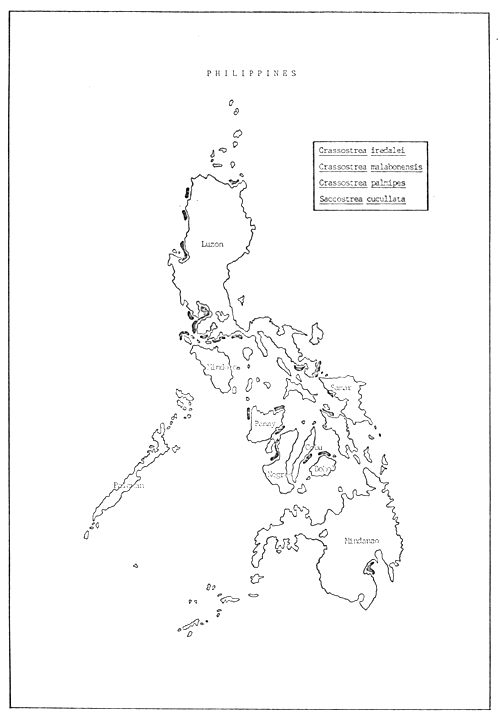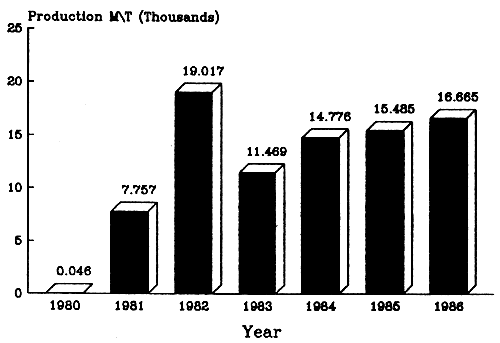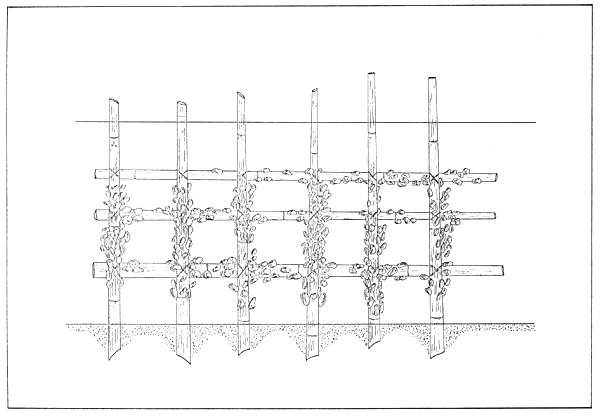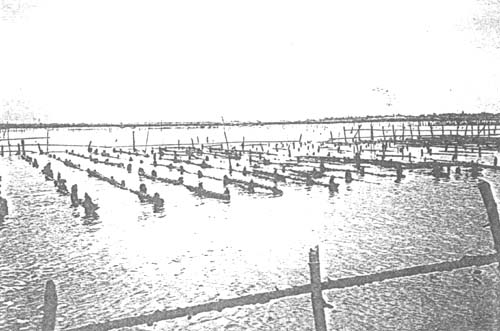Various species of oysters are found in almost the entire coastal areas of the country and they are particularly abundant in bays and estuaries that have some runoff from the land. Four species of oysters are cultured in the Philippines, the slipper-shaped oyster Crassostrea iredalei, the subtrigonal oyster C. malabonensis and the curly or palm rooted oysters C. palmipes and Saccostrea cucullata. The species receiving particular attention in terms of culture are C. iredalei, which are usually 6–9 cm long when marketed and the moderately sized C. malabonensis, which are usually 4–5 cm long. The above species are particularly abundant in Bacoor Bay and extend to the entire Manila Bay from Tarnate, Cavite to Mariveles, Bataan, along the coast of Northern Luzon, Lingayen Gulf, Tayabas and Sorsogon; and to some extent in Batangas Bay, Banate Bay in Iloilo, Binalbagan, Hinigaran and Himamaylan, Negros Occidental, and in areas around Catbalogan, Western Samar, Northern Leyte and Palawan. Commercial farming however tends to concentrate along the coast of various provinces largely in Bulacan, Capiz, Cavite, Pangasinan, Sorsogon and Negros Occidental (Table 8 and Fig. 16). Oyster production figures from 1980 to 1986 are shown in Figure 17. The highest output during this period occurred in 1982 with a production of 19,017 MT, whereas the production dropped to 11,469 MT the following year (Fig. 17). From 1983 to 1986 there was an annual growth rate of about 36 %. The total area of oyster farms in operation in 1986 was 467 hectares in contrast to the 707 hectares the previous year (Malig and Edra, 1987). Such decline was attributed to the rising production costs and slack demand due mainly to the poor sanitary quality of the product.
Four methods of oyster culture are practised in the Philippines; broadcast (sabong), stake (tulos), lattice and hanging (bitin, sampayan, horizontal, and tray) methods.
Broadcast method. The broadcast method is the most simple and
primitive method and it is adopted in areas with firm enough
bottoms to support the collectors. Empty oyster shells, stones,
logs and tin cans are scattered over the selected area where
natural setting occurs. Oyster spats are grown to the commercial
size on the collectors.
The advantage of the method is the low investment required,
whereas the major disadvantages are that it can be used only in
coastal areas with firm bottoms and shallow waters, high
mortalities due to silt and predation, and difficulty in
harvesting.
Stake method. The stake method is usually used in areas with
relatively shallow waters and soft muddy bottoms. The main
material used in this culture system is bamboo poles (5–9 cm in
diameter), however other rigid poles such as split coconut trunks
and tree branches are often used. The stakes are driven into the
bottom in rows and spaced 0.5 m apart (Fig. 18). The tip of the
stake extends to the high water level, due to the fact that
oysters can survive and grow in the intertidal zone (Plate 4 and
Plate 5).
The bamboo poles provide a clear surface to which the oyster
larvae settle after their pelagic phase. Culturists often
increase the attachment surface by adding horizontal bamboo
sections or by clipping empty oyster shells or other hard
materials to the stakes.
This culture method is commonly used in Binakayan in Cavite,
Binloc in Dagupan, Binmaley in Pangasinan and in Abucay in
Bataan.
The main advantage of this method compared to the broadcast one
is that spat mortality is greatly reduced, and growth rate and
production per unit area are increased. The disadvantages are
that predators such as crabs, starfish, and burrowing snails can
easily crawl up the stake and reach the oysters, the high cost of
bamboo poles if not locally available and the relatively short
life-span of the poles (1–2 years).
Lattice method. In this method bamboo splits are used to
construct a lattice which is held together with galvanized wire
or monofilament nylon twine. The splits are spaced about 15–30
cm apart and usually one lattice unit comprises 10–16 splits,
which can be easily handled by one operator. This structure can
be positioned in a great variety of ways, either horizontally or
vertically. In the fence style the lattice is stuck on the
bottom or supported by bamboo poles. It can also be mounted on
rocks or suspended in the water column when mounted on long
bamboos or empty drums.
The above method is popular due to a number of advantages: the
lattice can be used alone or in groups; collection and fattening
of oysters occur efficiently, and harvesting is simple.
Hanging method. Another effective and practical practice is the
hanging method. Empty oyster shells or coconut shells are used
as collectors. These are strung together on a synthetic rope and
held 10 cm apart by spacers, such as bamboo tubes or knots made
on the twine. Often collector shells are not spaced during the
spatting season but are restrung with spacers during the grow-out
phase. Usually each collector measures from 1–2 m depending upon
the depth of the water.
Variations of the hanging method are being used in the
Philippines. In the bitin or inhitin variation the collectors
are fastened on a bamboo platform or fence with bamboo posts
attached horizontally near the high-tide level (Fig. 19). The
collectors are spaced at regular intervals of 25–30 cm. In the
sampayan or long-line variation four or more parallel lines,
approximately 20 m long and 20 cm apart, are strung between two
bamboo poles. The cultches are fixed at regular intervals on
the above lines. In the tray method, bamboo trays are used to
hold the collectors. Rafts made of 5–6 bamboo poles are also
employed. The rafts are moored to the four corner posts with
enough slack to allow the raft to float at different water
levels. The hanging collectors are fastened 30–60 cm apart.
During the harvesting process, the collectors are merely untied
from the bamboo poles and hauled to a raft or small boat.
The advantages of the hanging method are many, such as the high
productivity per unit area and no mortality from silt and
crawling predators. Disadvantages include the cost of materials
(rope, bamboo, etc.), and the requirement of floats, anchors and
anchor lines if the raft system is used.
Poor sanitary quality and limited demand are probably the major
reasons for the failure of oyster farming to expand rapidly. Due
to the former constraint the Philippine oyster export market is
practically non existent.
Other problems in this culture system range from fouling
organisms (eg. ascidians and algae) to siltation. However, these
constraints can be avoided by correct management and by the
adoption of the suitable culture technique for a given area.
The shellfish industry in the Philippines is facing the problems of direct displacement of farming areas by housing and industrial estates and of environmental deterioration. There is a strong concern for the need to develop adequate sanitation standards and methods. Considerable work on bivalve depuration has been recently carried out by the Department of Fish Processing Technology of the University of the Philippines in the Visayas, in cooperation with the German Deutsche Gesellschaft für Technische Zusammenarbeit (GTZ) (Barile, Pers. comm., 1987). A simple purification unit has been successfully tested, however, the installation of such a system by single farmers would not be economically feasible due to the present low price of oysters.
| SPECIES | REGION | LOCALITY | NOTES |
| Crassostrea iredalei Crassostrea malabonensis Crassostrea palmipes Saccostrea cucullata | Northern Luzon | Lingayen Gulf, Pangasinon | Natural oyster beds and fisheries. Commercial scale culture in Pangasinon. |
| Central Luzon | Bulacan | Natural oyster beds and fisheries. Commercial scale culture. | |
| Southern Luzon | Bacoor Bay (Cavite), Manila Bay, Tarnate, Mariveles (Bataan), Tayabas Bay (Quezon), Batangas Bay, Palawan | Natural oyster beds and fisheries. Commercial scale culture in Cavite. | |
| Bicol | Sorsogon Bay (Sorsogon) | Natural oyster beds and fisheries. Commercial scale culture. | |
| Western Visayas | Banate Bay (Iloilo), Binalbagan, Hinigaran, Himamaylan (Negros Occidental) and Capiz | Natural oyster beds and fisheries. Commercial scale culture in Negros Occidental and Capiz. | |
| Eastern Visayas | Catbalogan (Western Samar), Northern Leyte | Natural oyster beds and fisheries. |

Figure 16: Major oyster farming areas in the Philippines.

Figure 17: Oyster production data in the Philippines from 1980 to 1986. (Source: Malig and Edra, 1987).

Figure 18: Oyster stake culture system as practised in the Philippines.

Figure 19: Oyster hanging (bitin) culture system as practised in the Philippines.

Plate 6: Oyster culture by the stake method in Cavite Bay, Philippines.

Plate 7: Oyster stake culture during low tide, Cavite Bay, Philippines. Small guard-house built on stilts is visible on the background.